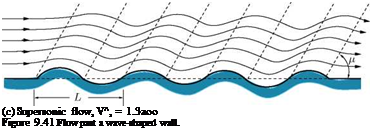Flow over a Wave-Shaped Wall 507404511
Consider a uniform flow of velocity Vx over a two-dimensional wave-shaped wall, as shown in Figure 9.41, with wavelength L and amplitude h.
Let the wall shape be defined by the equation:
zw = h sin(Xx). (9.201)
In Equation (9.201), subscript w stands for wall and X = 2л/L. Let us assume h ^ L, so that linear theory can be applied. By kinematic flow condition [Equation (9.68)], for z ^ 0, we have:
—- = —XXL – = hX cos (Xx). (9.202)
Lx, dx
Now, with this background, let us try to solve the governing equation for incompressible flow, compressible subsonic flow and supersonic flow.
9.25.1 Incompressible Flow
The governing equation for incompressible flow is the Laplace equation:
Fx + Фzz = 0.
This can be solved by expressing the potential function as:
Ф^, z) = F(x) G(z).
Solving by separation of variables, we get:
![]() ф^, z) = — Vxhe Xz cos (Xx).
ф^, z) = — Vxhe Xz cos (Xx).
 V
V
The potential function given by Equation (9.203) is only the perturbation potential. Obtaining the expression for ф, given by Equation (9.203), is left as an exercise to the reader.
Using Equation (9.203), we can easily get the resultant velocity U and perturbation velocity w as:
U = + u = VOT ^ 1 + hke~lz sin (kx) j (9.204a)
w = V(x, hke^kz cos (kx). (9.204i>)














